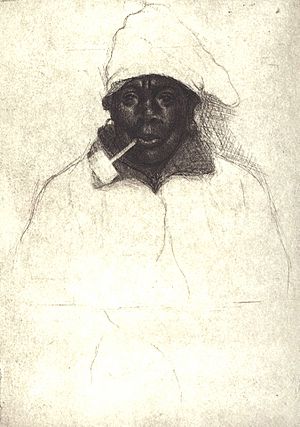Joseph Holston facts for kids
Joseph Holston (born April 6, 1944) is an American artist. He is famous for his paintings and prints that show the African American experience. He uses bright colors and strong lines in a style that mixes cubism and abstract art. He works with paint, etchings, silk screen, and collage.
Contents
Joseph Holston's Life and Art Journey
Joseph Holston grew up in a small Black community called Hawkins Lane. This was in Chevy Chase, Maryland, near Washington, D.C. His childhood in this close-knit community helped him feel proud of his Black identity. This pride shows in his artwork. In 1960, his family moved to Washington, D.C. There, Holston joined a commercial art program at Chamberlain Vocational High School.
From 1964 to 1970, Holston worked as a commercial artist. He also took art classes around Washington, D.C., to learn more. One of his teachers was Marcos Blahove (1928-2012), a well-known portrait painter. In the summer of 1971, Holston traveled to Santa Fe, New Mexico. He studied with Richard Vernon Goetz (1915-1991), who painted portraits, landscapes, and still life.
A few months after returning to Washington, D.C., Holston quit his commercial art job. He decided to become a full-time painter. The next year, his painting Ghetto Boy was bought by businessman W. Marvin Watson Jr. It was then given to the Lyndon Baines Johnson Library and Museum.
Exploring Etchings and New Styles
In 1974, Holston was inspired by Rembrandt's prints. He began to create his own etchings. Etching is a type of printmaking where an image is carved into a metal plate. Artists use different techniques to create various visual effects. Holston used methods like hard ground, soft ground, and aquatint in his etchings.
One of his first prints was Woman with Pipe (1974). This artwork is now part of The Phillips Collection in Washington, D.C. Other prints by Holston are in the Smithsonian American Art Museum and other museum collections.
Holston had his first solo museum show in 1975. It was at the Butler Institute of American Art in Youngstown, Ohio. The next year, he spent three months in Tanzania. There, he painted and taught art workshops at the University of Dar es Salaam.
After this time, Holston's art began to change. His work moved from being purely realistic to using "bold color, expressive forms, and rhythmic lines." He also started creating collage works. From 1979 to 1990, he learned more about printmaking. He made etching-collagraphs and screen prints. After 1990, he continued to print his own etchings. He also started working with a master screen printer.
Exhibitions and Recognition
A special exhibition of his prints was held from 2010 to 2011. It was called Limited Editions: Joseph Holston Prints, 1974 - 2010. This show was at the University of Maryland's David C. Driskell Center. It also went to the African American Museum in Philadelphia.
In 2020, two of Holston's works were in a special show. His oil painting The Elder and his etching Charity were part of The Phillips Collection's 100-year anniversary exhibition. This show was called ″Seeing Differently: The Phillips Collects for a New Century.″
In 2024, Holston had a solo exhibition called Joseph Holston: Call and Response. It was shown at the American University Museum at the Katzen Arts Center.
He has also had major solo exhibitions at other museums. These include the Washington County Museum of Fine Arts and the Southern Alleghenies Museum of Art. He has also been an Artist-in-Residence at several universities.
Color in Freedom: A Journey Along the Underground Railroad
In 2008, Holston created a powerful art series. It tells the story of the journey from slavery to freedom. This series is called Color in Freedom: Journey along the Underground Railroad. It includes over fifty paintings, etchings, and drawings.
The collection is divided into four parts, like movements in music:
- I. The Unknown World: This part shows the journey of captive Africans. It depicts them moving through the Middle Passage and to the slave block.
- II. Living in Bondage--Life on the Plantation: This section shows what life was like for enslaved people.
- III. The Journey of Escape: This part tracks the path to freedom.
- IV. Color in Freedom: This final part celebrates reaching freedom and new beginnings.
This project shows how artists can use their work to help us understand history. Since it first opened in 2008, the collection has traveled widely. It has been shown in museums and galleries across the country and around the world. In 2010, it was even shown at the United Nations in Geneva, Switzerland. Parts of the series were also shown at Brown University in 2016.
Public Collections
Joseph Holston's art can be found in many public collections, including:
- Amarillo Museum of Art
- Baltimore Museum of Art
- Butler Institute of American Art
- DuSable Museum of African American History
- Federal Reserve Board Fine Art Collection
- Georgia Museum of Art
- Library of Congress Fine Print Collection
- Honolulu Museum of Art
- Mount Holyoke College Art Museum
- North Carolina A&T State University
- Pennsylvania Academy of the Fine Arts
- Reginald F. Lewis Museum of Maryland African American History & Culture
- Schomburg Center for Research in Black Culture, New York Public Library
- Smithsonian American Art Museum
- Southern Alleghenies Museum of Art
- The Phillips Collection
- United States Mission to the United Nations in Geneva
- University of Maryland Global Campus
- Washington County Museum of Fine Arts
- Yale University Art Gallery


